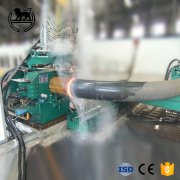Chinese | English

Skype: zhiguang.wu
Email:15230713671@163.com
Address: North Mengcun Industrial Park, Mengcun Hui Autonomous County, Cangzhou, Hebei.
Medium frequency pipe bender How to calculate the size
Intermediate frequency pipe bender is a device used to bend metal pipes, which uses an intermediate frequency current to generate heat on the pipe and change the shape of the pipe through pressure. Calculation of bend size requires consideration of several factors, including pipe material, pipe diameter, bending Angle, bending radius, etc. The following details how to calculate the bend size.
First, the material and diameter of the pipe must be determined. Common metal pipes include stainless steel, carbon steel and copper pipes. Pipe diameter can be determined by measuring or consulting relevant standards.
Next, determine the desired bending Angle and bending radius. The bending Angle refers to the degree of change in the direction of the pipe at the bend, and the common angles include 90 degrees, 45 degrees and 180 degrees. Bending radius refers to the curvature radius of the pipe at the bend, which directly affects the bending performance and appearance of the pipe.
Then, according to the pipe material and diameter, find the corresponding bending radius standard. Pipes of different materials and diameters generally have corresponding bending radius standards, which can be found in relevant industry standards or specifications. If no standard is available, the appropriate bending radius can be selected according to practical needs and experience.

Next, calculate the length increment generated when bending. When the pipe is bent, the outer and inner arcs of the pipe stretch and compress, which increases or decreases the length of the pipe. To calculate the length increment, you can use the bending length formula: ΔL = R × θ, where ΔL is the length increment, R is the bending radius, and θ is the bending Angle (radian).
Finally, the total length of the bent pipe is calculated. The total length is equal to the original pipe length plus the length increment: L = L0 + ΔL, where L is the total length of the bend and L0 is the original pipe length.
It should be noted that the above calculation method is applicable to a single bend on a straight line segment. For complex multiple bending, it is necessary to calculate step by step according to the actual situation.
In addition to the above basic calculations, other factors should also be considered, such as the accuracy requirements of the bending pipe, the influence of the pipe wall thickness on the bending performance, and the working capacity of the equipment. Therefore, in actual operation, it is recommended to refer to the relevant standards, specifications and equipment operation manuals to ensure the accurate calculation of the bending size and the guarantee of production quality.
Together, the calculation of bending pipe size needs to determine the pipe material and diameter, bending Angle and radius, and refer to the relevant standards and formulas for calculation. In actual operation, other factors need to be considered to ensure bending quality and accuracy.
For more information about medium frequency pipe bending machine, please pay attention to our website: http://www.xhxhhsl.com/
